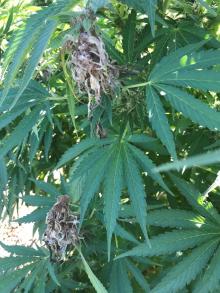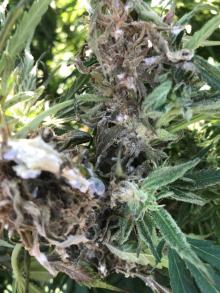By C. M. Ocamb
Cause The fungus, Sclerotinia sclerotiorum, causes stem cankers and bud rot in hemp. Hemp plants infected in outdoor settings have been observed in Oregon since 2019. Other susceptible host plants include bean, carrot, pea, lettuce, potato, green pepper, cucurbits, parsnip, radish, sunflower, herbs including mint, fruit trees including apple, nectarine, and sweet cherry, and a large number of ornamentals both woody and herbaceous. Weeds can also be host to S. sclerotiorum; dandelion (Taraxacum officinale) is a very susceptible weed host. Stem infections can cause severe losses in seed crops.
This fungus survives as sclerotia, which may be associated with infected plant residues, contained in seed lots (external or internal to seed), or persist in the soil. Sclerotia can survive three to five years in the soil, depending on environmental conditions and cropping practices. Typically, strains of this fungus outside of tropical zones require a conditioning period in moist soil of several weeks at 40°F or cooler temperatures, after which sclerotia can germinate in soil when the soil water potentials are ≥-100 kPa and temperatures are between 41°F and 68°F. The production of apothecia appears to be prevented when soil matric potentials are below -0.05 MPa. The upper temperature threshold for conditioning and germination of sclerotia is 68°F and 77°F, respectively. Typically, sclerotia germinate and then produce a small, stalked, cup-shaped fruiting structure known as an apothecium, which forcibly ejects millions of ascospores into the air. Sporulating apothecia may persist five to ten days while released ascospores can survive up to two weeks, depending on environmental conditions. Since ascospores require an exogenous nutrient source before infecting a plant, the primary sites for initial infection are senescing tissues such as spent blossoms and declining leaves or plant tissues that have suffered mechanical injuries or wounding through infection by other pathogens. For infection, ascospores require free moisture or a relative humidity close to 100% with a temperature between 50°F and 86°F. Sometimes sclerotia germinate and produce undifferentiated mycelium that directly infects plant portions just below or at the soil line. After infection of the plant has occurred the mycelium spreads by hyphal growth, the fungus can then invade any healthy, vigorous part of a plant with which it comes in contact, and the pathogen may grow from plant to plant if a diseased plant is in direct physical contact with neighboring plants. Moist conditions within the plant canopy favor infection, as do rain, dew, and/or irrigation practices that keep foliage wet for long periods.
Symptoms The first symptom is usually water-soaked lesions on leaves and buds. The fungus may invade the stem portion near infectedbuds, causing death of the upper shoot portion but cankers can develop lower on plant stems. Infected stems and buds may be whitish in appearance due to the production of fluffy, white-colored mycelium. Infected buds frequently have sclerotia embedded in them both internally and on external surfaces. Newly forming sclerotia are white and change to black when fully developed.
Cultural control
- Improve air circulation and minimize leaf wetness.
- Remove and destroy infected plant portions.
- Rotate with non-hosts for 8 years to achieve best control, but for at least two years to reduce population of sclerotia; grasses and cereals are not affected by white mold.
- Deep plowing buries sclerotia but plowing later years may return viable sclerotia to the surface.
- Field flooding during warm temperatures destroys sclerotia.
Biological control
- Contans WG at 1 to 4 lb/A, depending on depth of incorporation, as a preplant or postharvest treatment. Incorporate thoroughly in the top 2 inches of soil. 4-hr reentry. O
References Caesar, A.J., and Pearson, R.C. 1983. Environmental factors affecting survival of ascospores of Sclerotinia sclerotiorum. Phytopathology 73(7):1024-1030.
Garfinkel, A. R. 2021. First report of Sclerotinia sclerotiorum causing stem canker on Cannabis sativa in Oregon. Plant Disease 105: https://doi.org/10.1094/PDIS-10-20-2142-PDN.
Hao, J.J., Subbarao, K.V., and Duniway, J.M. 2003. Germination of Sclerotinia minor and S. sclerotiorum sclerotia under various soil moisture and temperature combinations. Phytopathology 93:443-450.
Koike, S. T., Stanghellini, H., Mauzey, S. J., and Burkhardt, A. 2019. First report of Sclerotinia crown rot caused by Sclerotinia minor on hemp. Plant Disease 103: https://doi.org/10.1094/PDIS-01-19-0088-PDN.
Mila, A.L., and Yang, X.B. 2008. Effects of fluctuating soil temperature and water potential on sclerotia germination and apothecial production of Sclerotinia sclerotiorum. Plant Dis. 92:78-82.




